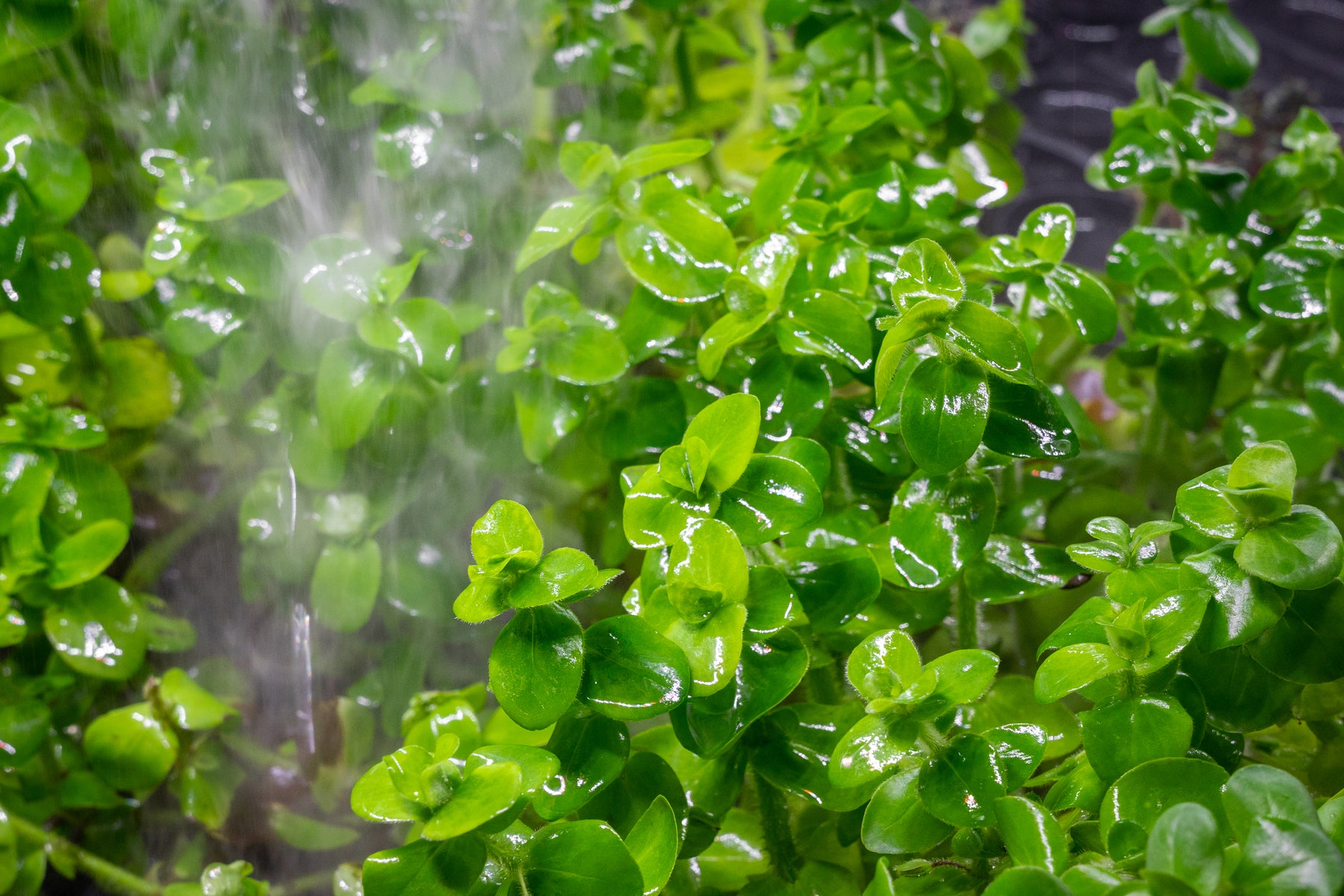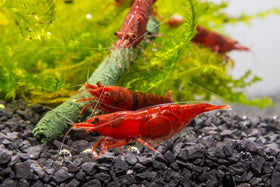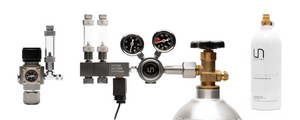
Emersed vs. Submerged-Grown Aquatic Plants for Aquascaping
When setting up any planted tank, choosing the right plants for your aquarium is an important decision. In the hobby, it has become quite a topic for debate - Is it better to plant submerged or emersed aquatic plants in your aquarium?
Contrary to some opinions, aquatic plants grown emersed offer a range of advantages because of their unique biological characteristics.
Emersed plants develop roots quickly upon submersion, show resilience against pests and deficiencies, and offer natural adaptations that allow for a faster transition and adaptation. These benefits make emersed-grown aquatic plants the ideal choice for passionate aquarists.
In this article, we'll highlight the benefits of using emersed-grown plants in planted aquariums. We'll also discuss why it's arguably smarter to ship and plant emersed plants over submersed plants. Finally, we'll debunk myths about converting emersed-grown plants to their underwater form.
Keep reading to uncover why emersed-grown plants may be the better choice for your planted tank!
This article will go over:
- Advantages of Emersed Plants
- Why Emersed Plants Ship Better
- Tips for Transitioning Emersed Plants
- Short-term Disadvantages of Emersed Plants
- Final Notes on Emersed Plants

Advantages of Emersed Plants
Emersed live aquatic plants have unique advantages that make them significantly more robust than their submerged forms. During this phase, plants grow above the water level, developing leaves specifically adapted to terrestrial conditions. This adaptation allows them to endure exposure to air and directly absorb carbon dioxide from the atmosphere.
Unlimited access to atmospheric CO2 and light above the aquarium waterline allows emersed plants to grow healthy and strong. This in addition to easy nutrient absorption from the partly submerged environment fosters vigorous plant growth. Maximum energy is stored within the plant while emersed, resulting in robust stems and thicker leaves. In many species, the emergence of flowers also aids in pollination by insects or wind.
This lifecycle enhances the plant's capacity to withstand challenging conditions like flooding, rainy seasons, or winter. It boosts their resilience for subsequent growth and propagation. The ability to endure "adverse conditions" mimics the setup of a freshwater tank.
 Shown: Emersed Hydrocotyle Leucocephala
Shown: Emersed Hydrocotyle Leucocephala
As a result of this natural strength, emersed plants have several key advantages over their submerged forms when used in the home aquarium. We have compiled information found in peer-reviewed scientific journals that explain these advantages of emersed-grown plants:
1. Rapid Root Development
Emersed-grown live plants exhibit remarkable adaptability, swiftly initiating root growth upon submersion. The Amazon Sword (Echinodorus species) and Cryptocoryne species are exemplary in showcasing accelerated root development, anchoring themselves firmly in the substrate within a short period post-submersion (Reference: "Study on Adventitious Root Formation in Aquatic Plants" - Aquatic Botany, n.d.).
2. Pest and Disease Resistance
Emersed-grown freshwater plants show a reduced susceptibility to common aquarium pests and diseases. Slow-growing species such as Anubias, Java Fern (Microsorum pteropus), and Bucephalandra are among the species displaying fewer instances of infestations by snails or algae growth when cultivated in emersed conditions. (Reference: "Effects of Growth Conditions on Pathogen Incidence in Aquatic Plants" - Journal of Aquatic Plant Management, n.d.).
-
NOTE: Tissue Culture Aquarium Plants are grown emersed in sterile conditions, making them 100% pest and algae-free. Tissue culture plants are many hobbyists' ideal choice for their aquariums because of this fact. Starting as clean as possible from the start is a common goal, which is why many choose these in-vitro aquatic plants when aquascaping. Click here to explore our tissue culture plant selection.
3. Adaptation Advantage
In-depth scientific investigations have shed light on the intricate physiological adaptations observed in aquatic plants cultivated in emersed conditions. These adaptations are vital when the plants transition from their partially submerged (emersed) environments to fully submerged conditions. The findings also reveal important insights into how these plants smoothly adapt to different environments. (Reference: "Physiological Adaptations of Aquatic Plants during the Transition from Emersed to Submersed Growth" - Hydrobiologia, n.d.).
4. Nutrient Absorption
Emersed-grown plants often possess specialized root structures that enhance nutrient absorption upon submersion. Plants like Dwarf Sagittaria (Sagittaria subulata) and Eleocharis exhibit specialized root systems that enable efficient nutrient uptake, aiding their growth upon submersion. (Reference: "Root Morphology and Nutrient Uptake in Emersed and Submersed Aquatic Plants" - Aquatic Botany, n.d.).
5. Compatibility with Low-Tech Setups
Many types of plants can easily adapt from their emersed environment to low-tech aquarium setups. Examples like Java Moss (Taxiphyllum barbieri) and Hornwort (Ceratophyllum demersum) thrive with minimal lighting and can sustain growth without the need for extensive CO2 supplementation after being submerged. (Reference: "Adaptability of Emersed Grown Aquatic Plants to Low-Tech Aquarium Environments" - Aquatic Sciences Journal, n.d.).
6. Improved Water Oxygenation
Emersed-grown plants are linked to high levels of oxygen in the aquarium water due to rapid photosynthesis. Plants such as Water Sprite (Ceratopteris thalictroides) and Water Wisteria (Hygrophila difformis) augment oxygen levels in the water column through their rapid photosynthetic activity. (Reference: "Oxygenation Effects of Emersed Grown Aquatic Plants in Submerged Conditions" - Aquatic Ecology Research, n.d.).
 New submerged growth on Rotala Blood Red
New submerged growth on Rotala Blood Red
Why Emersed Plants Ship Better
Emersed plants exhibit a remarkable advantage in handling the shipping process compared to their submersed counterparts. The key lies in their hardiness and ability to adapt during the emersed growth phase. Plants cultivated above the waterline grow leaves adapted to terrestrial conditions, creating a sturdier and more resilient structure.
This natural hardiness makes emersed plants better suited to withstand transportation, where they may face fluctuations in temperature, humidity, and physical handling.
Ultimately, emersed plants experience less damage and stress during shipping, which leads to higher survival rates. This resilience results in healthier plants and increases the chance of success when transitioning them to life underwater.
Aquarium plant suppliers, such as Buce Plant, consider all of the benefits of emersed grown plants when offering aquatic plants by mail order. However, there may be instances where submerged-grown plants are preferred by hobbyists, such as in exchanges between trusted local hobbyists.

Tips for Transitioning Emersed Plants
When emersed plants are first submerged, you can expect the emersed-grown leaves to melt back. However, the plant quickly replaces them with new submerged-grown leaves (sometimes within a week.)
One common misconception amongst hobbyists is that emersed-grown plants are inferior to submersed-grown plants because the emersed plant has to transition to life underwater. While the transition from an emersed to submerged form takes a little time and patience, the benefits of using emersed plants and allowing them to transition in your tank far outweigh the challenges aquarists might encounter.
Achieving a successful transition from emersed to submersed growth for new plants demands attention to some key fundamentals:
-
Check Your Parameters - Start by ensuring optimal water quality, checking water parameters, and maintaining appropriate water temperature.
-
Supply Nutrients - Normally, transitioning plants require plant fertilizers or a nutrient-rich soil too meet your plant's needs. This will help prevent nutrient deficiencies that can stunt growth.
-
Proper Lighting - Ensure your aquarium light is at an appropriate light intensity and duration.
- Plant Pruning - Trimming of dead or melting leaves is crucial for encouraging healthy leaf growth. Pruning plays a pivotal role in assisting transitioning plants. A general rule is to trim leaves showing significant melting or excess algae growth. Regular pruning of damaged plant leaves encourages new growth that is healthier, stronger, and perfectly adapted to the submersed environment.
For more tips on growing healthy aquarium plants, read our in-depth article: How to Prevent Aquarium Plant Melt

Short-term Disadvantages of Emersed Plants
Acclimating emersed plants to their submerged form in their aquarium can be challenging for some. However, it is usually manageable with the right water conditions and patience.
Transition Period
When introducing emersed plants to a submerged environment, it's common for plants to undergo a transition period marked by plant melt. This initial adaptation period is a natural response as the plants acclimate to their new underwater surroundings, laying the groundwork for future submerged growth.
Initial Aesthetics
When first submerging plants in an aquarium, they may not look the same as mature submerged plants. You can expect many types of plants to look different in their emersed form. Patience is key during this period, as the plants undergo their necessary acclimation. Over time, as the emersed plants establish themselves, they will soon display their true aesthetic value.
Slower Growth Progress
Some emersed-grown plants may exhibit slower growth rates initially after submersion. An example of a slow-grower is Bucephalandra. The plants acclimating to growing underwater may cause a temporary delay in growth. With proper care and patience, these emersed plants will gradually acclimate, leading to robust growth in the long run.
Final Notes on Emersed Plants
When comparing emersed and submersed grown aquatic plants, the benefits of emersed forms make a compelling case for their adoption in the home aquarium.
Emersed plants offer rapid root development, increased resistance to pests and diseases, and specialized adaptations that foster smoother transitions from emersed to submerged environments. They are great for freshwater aquariums because they can absorb nutrients efficiently, are compatible with low-tech setups, and increase oxygenation in the aquarium.
Growing plants emersed allows them to take advantage of unlimited CO2, ample light, and optimal nutrient absorption. This later leads to long-term plant health and growth in your fish tanks. Despite being a debated topic, emersed plants offer various benefits because of their resilient characteristics.
Check out the progression results of our UNS 90 aquarium planted with only emersed-grown plants:

Tell us - Was this article helpful? Please comment your thoughts below!
If you have any questions regarding this article, please DM us on Instagram or Facebook (@buceplant), or email us directly at support@buceplant.com so we can assist you - questions will not be answered here.





Comments
Leave a comment